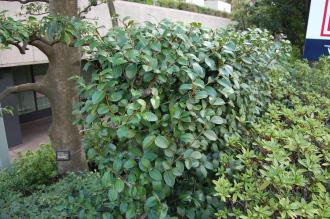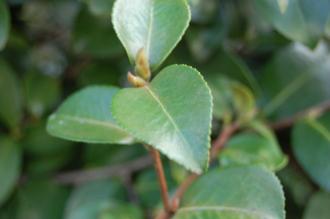
Camellia sasanqua (01/04/2015, Tokyo, Japan)
Position: Full sun to shade
Flowering: Late autumn to winter
Soil: Moist, well-drained, acidic
Eventual Height: 5m
Eventual Spread: 5m
Hardiness: 7a, 7b, 8a, 8b, 9a, 9b
Family: Theaceae
Camellia sasanqua is an evergreen winter flowering shrub with a bushy habit. Its dark green leathery leaves are elliptic with serrulate margins, paler on the underside, up to 7cm long and 3cm broad. Its white to deep pink flowers have protruding yellow stamen, are up to 7cm across and appear along the branches, particularly at the ends. The fruit consists of a three compartmented globe shaped capsule.
Camellia sasanqua, commonly known as Sasanqua Camellia, is native to Japan and China. In it native habitat it grows at an altitude of up to 900m as part of a mixed scrub mosaic. It has a long history of cultivation in Japan, its leaves being used for tea and its seed being used for oil production.
The etymological root of the binomial name Camellia is derived from and named after the botanist George Kamel. Sasanqua is derived from the vernacular Japanese name for this plant.
The landscape architect may find Camellia sasanqua useful as an evergreen winter flowering shrub which will tolerate shaded conditions and acidic soils. It may also be used as an effective evergreen hedge, it should be noted that flowering will be greatly reduced if it is used for this purpose.
Ecologically, Camellia sasanqua is of little wildlife value in the UK.

Camellia sasanqua Leaf (01/04/2015, Tokyo, Japan)
The Royal Horticultural Society has given a number of varieties of Camellia sasanqua their prestigious Award of Garden Merit.
Camellia sasanqua prefers moist, humus rich, fertile, well-drained soils. It prefers neutral to acidic soils. It dislikes dry soils.
Camellia sasanqua requires little maintenance. If necessary, pruning should be carried out after flowering.

